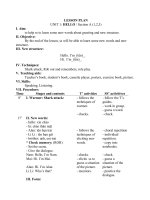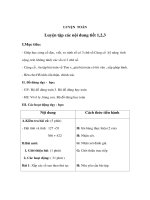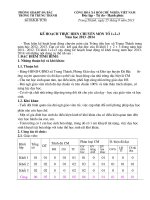INNOVATION TEACHING METHODS EDUCATION PROJECT GRADE 3 ENGLISH COURSES FROM WEEK TO WEEK 1 2 BY KNOWLEDGE SKILLS STANDARDS.
Bạn đang xem bản rút gọn của tài liệu. Xem và tải ngay bản đầy đủ của tài liệu tại đây (523.65 KB, 30 trang )
/>PRIMARY DOCUMENTS PROFESSIONAL.
INNOVATION TEACHING METHODS
EDUCATION PROJECT GRADE 3
ENGLISH COURSES
FROM WEEK TO WEEK 1 2
BY KNOWLEDGE SKILLS STANDARDS.
2015
/> />Foreword
During the period of socialization and the current international
integration, Vietnam human resources becomes significant,
decided the success of the development of the country. Education
growing role and important tasks in building a new generation of
Vietnam, meet the requirements of economic development -
social. Party and State always pay attention and focus on
education. With the theme of the year was "continuing
management innovation and improve the quality of education"
for secondary education. But in the national education system,
the primary school is an important foundation degree opening, it
has very important significance was initially formed human
personality is also the starting grade school to help students form
into the initial basis for the development of proper and ethical
long term, intellectual, physical, aesthetic and basic skills for
students continuing Elementary. To achieve this goal requires
the teaching must have deep knowledge and understanding of the
content specific program of activities organized, able to
understand the physiology of the young mind, the needs and
possibilities child's performance. At the same time, the teacher
has the ability to use flexible methods and forms of teaching suit
pupils. Currently sector undertakings are learning skills
Knowledge Preparation courses.
- Respect the student's progress in learning and training,
encouragement not pressure for assessing students. Create
conditions and opportunities for all students to complete the
program and have the array object knowledge for gifted students
in particular subject-subject information is new to the students.
Also in the process of implementing innovative teaching
methods based on the primary new awareness of students about
the exciting activities, learning and training in them, based on
/> />organizational capacity, design and the activity in the teaching
process in teachers. Improving the quality of education and
teaching is essential. it represents the first lesson - a lesson plan
needs innovation of students. Teachers study, preparation,
lectures, guide the children explore the natural knowledge
without enforcement, lesson creation is also essential to help
teachers teach informatics initiative when promoted.
Proudly presents you with teachers, parents and patrons
with reference and document experience:
INNOVATION TEACHING METHODS
EDUCATION PROJECT GRADE 3 ENGLISH COURSES
FROM WEEK TO WEEK 1 , 2
BY KNOWLEDGE SKILLS STANDARDS.
Legs to thank!
/> />INNOVATION TEACHING METHODS
EDUCATION PROJECT GRADE 3 ENGLISH
COURSES
FROM WEEK TO WEEK 1 , 2
BY KNOWLEDGE SKILLS STANDARDS.
Legs to thank!
WEEK: 1
Period 1 Unit 1: HELLO
Lesson 1(1, 2, 3)
I. Objectives:
1. Knowledge: - By the end of the lesson Ps will be able to:
Greet and self- introduce.
2. Skills:
- Develop Ss speaking and listening skills
3. Language focus:
- Sentence Partners: - Hello/ hi. I’m + name.
- Vocabulary: hello, hi, I, am, nice to meet you.
II. Teaching aids:
1. Teacher’s: student’s and teacher’s book, pictures, cassette.
2. Students’: books, notebooks, workbooks.
III. Teaching processes:
1. Class organization:
- Greeting
- Checking for the students' attendance.
2. Oral test:
- Check pupils’ books, note books ……
3. New lesson:
Teacher’s actions Students’ actions
Warm up
/> /> Say hello to the class and introduce
yourself, using Hello. I am + name.
Walk around the class to say hello again
to some pupils and ask them to answer.
1. Look, listen and repeat
Ask students to look at the picture in the
book and ask:
Who are they in the picture?
Where are they?
Ask students listen and repeat after the
tape
Repeat again and read in pairs
2. Point and say
- Teach vocabulary:
Hello Hi
Am = ‘m Nice to meet
you.
Checking: What and where
Note: difference between Hi / Hello.
Hi is very informal. Pupils can use with
friends but not with an adult, e.g a
teacher.
Hello is also informal and friendly but
more formal than Hi. It can be used with
teachers and other adults.
Setting the sense: - Have pupils look at
pictures. Ask them to identify the
characters in the pictures.
Who are in the pictures? What are
Greeting
Look at the
picture and
answer
They are teacher
and students
They are in the
class
Listen and repeat
after the teacher
Slap the board
Work in pairs
/> />they doing?
- Sentence Partners: - Hello
- Hi. I’m + name
I’m + name (I’m = I am)
- Call on a pair and ask them to pretend
to be Miss Hien and Nam to act out the
greeting exchange. Call on one more
pair to act out Mai and Quan to self-
introduce. Have the class repeat all the
phrases in this section and Teacher
correct the Ss pronunciation (stress,
assimilation of sounds and intonation)
- Call on some pairs to perform the task
at the front of the class. The rest of the
class observe and give comments if
possible.
- Make a few questions to check pupils’
comprehension of the language.
- Have the whole class repeat all the
phrases in chorus to reinforce their
pronunciation
3. Let’s Talk
Ask students to look at the pictures in
the book. Ask them to identify the
characters in the pictures.
Ask Ss work in pairs to greet and self-
introduce. Call some pairs to act out
Correct their pronunciation
4.Consolidation
Work in pairs
Do exercises.
Learn by heart the
new words and
structures.
/> />Asking Ps to focus on the structure once
again.
- Retell the content of the lesson.
5. Homework
Do exercises in the workbook. Learn by
heart the new words and structures.
Period 2: UNIT 1: HELLO
Lesson 1: Part 4-5-6
I. Objectives:
1. Knowledge: By the end of the lesson Ps will be able to:
greet and self- introduce.
2. Skills:
- Develop Ss writing and listening skills
3. Language focus:
- Sentence Partners
- Vocabulary:
/> />II. Teaching aids:
1. Teacher’s: student’s and teacher’s book, pictures, cassette.
2. Students’: books, notebooks, workbooks.
III. Teaching processes:
1. Class organization:
- Greeting
- Checking for the students' attendance.
2. Oral test:
- Have pupils greet and introduce their names.
3. New lesson:
Teacher’s actions Students’ actions
Warm up: Say hello to partner.
4. Listen and tick
- Have pupils look at pictures a, b, c and
d on page 7 of the Student Book. Elicit
the identification of the characters in the
pictures and the characters’ words. Tell
pupils that they are going to listen to the
recording and tick the pictures they hear.
Guess the answer
- Play the recording 2 times pupils to
listen and tick the boxes. Check their
guess. Compare the answer with the
partner.
- Play the recording again pupils check
their answers. T give the answer:
- Ask some questions to ensure pupils’
comprehension of the listening text.
Answer: 1.b 2.a
Greeting
Listen and tick
/> />5. Let’s write
- Have pupils open their books to Page
7. Get Ss to read the text. Tell pupils that
they are going to read and get the
information to write the missing words
in dialogue 1 and 2.
- Pupils read individually silently and
complete the dialogues.
- Pair works. Pupils give their answers
for correction.
- Ask some pupils to read their answers
aloud to the class. The rest of the class
listen and give comments.
- Make a few questions to check pupils’
comprehension of the reading text.
Answer: 1. Hello, I’m 2. I’m,
Hello.
6. Let’s sing
- Introduce the Hello Song, Page 7.
- Play the recording and listen the Hello
Song
- Play the recording again for pupils to
sing each line of the rhythm.
- Call on a group of six to the front of
the class and do the actions. The others
clap their hands after the song
- Group work. Pupils practise singing
and doing the actions in groups. Monitor
the activity and help them when
Work in pairs
Listen and sing
/> />necessary. Correct pronunciation Ss’
errors.
- Call on one group to perform the song
at the front of the class. The rest of the
class sing the song and clap the rhythm.
- Have class sing the song again to
reinforce their pronunciation.
4.Consolidation
Asking Ps to focus on the structure once
again.
- Retell the content of the lesson.
5. Homework
Do exercises in the workbook. Learn by
heart the new words and structures.
Do exercises in
the workbook
WEEK: 1
/> />Period 3: UNIT 1: HELLO
Lesson 2: Part 1- 2-3
I. Objectives:
1. Knowledge:
- By the end of this lesson, Students will be able to greet and
respond to greeting
2. Skills:
- Develop Ss speaking and listening skills.
3. Language focus:
- Sentence Partners: How are you? - I’m fine
- Vocabulary: bye, goodbye, Thanks, And you? How
II. Teaching aids:
1. Teacher’s: student’s and teacher’s book, pictures, cassette,
puppets.
2. Students’: books, notebooks, workbooks.
III. Teaching processes:
1. Class organization:
- Greeting
- Checking for the students' attendance.
2. Oral test:
- Ask Ss to greet to each other
3. New lesson:
Teacher’s actions Students’ actions
Warm up: Chatting
- T asks Ss to repeat the greeting and
introducing oneself.
1. Look, Listen and repeat.
Have Ss to look at the book at page 8.
Elicit the character and have Ss guess
Answer the
teacher’s questions
Look at the pictures
in the book
/> />what they are saying.
Set the scene: we are going to review
phrases saying hello and bye.
Have Ss listen to the recording as they
read the lines in the speech bubbles
Play the recording again for Ss to
repeat the lines in the speech bubbles
two times.
Divide the class into two groups. One
repeat Mai’s part and the other repeat
Nam’ part.
Play the recording again for the whole
class to repeat each line in the speech
bubbles to reinforce their
pronunciation.
Teach vocabulary:
Bye=goodbye How
Thanks= thank you And you
- Sentence Partners: How are you? -
I’m fine
2. Point and say
Have Ss look at the pictures on page 8
Elicit the characters in the pictures and
their names. Ask Ss to guess and
complete the speech bubbles.
T models/ allocates the parts of
characters Mai and Nam to Ss
Ask them to act out the dialogue1.
Repeat the step with some other pairs
Listen and repeat
Read in pairs
Look at 4 pictures
Point to the pictures
and practise
/> />for pictures
Have Ss practice acting out the
dialogue in pairs, using the pictures.
Monitor the activity and offer held.
Correct pronunciation errors (stress,
assimilation of sounds, intonation)
when necessary.
Call on some pairs to perform the task
at the front of the class. The others
observe and give comments.
Have the whole class repeat all the
phrases in chorus to reinforce their
pronunciation.
3 - Let’s talk:
Show picture and give task.
Have Ps work in pair to greet and
respond to greeting.
- Display in class, others comment
Listen and correct.
Have Ps do
4.Consolidation
Summary the lesson
5.Homework
- Do exercises in workbook, learn by
heart the new words
Play role and speak
out.
Work in pair
practice talking:
Do exercises in the
workbook
/> />Period 4: UNIT 1: HELLO
Lesson 2: Part 4-5-6
I. Objectives:
1. Knowledge: By the end of the lesson Ps will be able to:
Greet and respond to greeting.
2. Skills:
- Develop Ss reading, writing and listening skills
3. Language focus:
- Sentence Partners:
- Vocabulary:
II. Teaching aids:
1. Teacher’s: student’s and teacher’s book, pictures, cassette.
2. Students’: books, notebooks, workbooks.
III. Teaching processes:
1. Class organization:
- Greeting
- Checking for the students' attendance.
2. Oral test:
- Have pupils greet and introduce their names.
3. New lesson
Teacher’s actions Students’ actions
/> /> Warm up: Chatting
- T asks Ss to repeat the greeting and
introducing oneself.
4. Listen and number
- Have pupils look at pictures a, b, c
and d on page of the Student Book.
Give the identification of the
characters in the pictures and the
characters’ words. Tell pupils that
they are going to listen to the
recording and match the information
they hear to the pictures. They should
number the boxes.
- Play the recording 2 times pupils to
listen and number the boxes. Check
their guess. Compare the answer with
the partner.
- Play the recording again pupils
check their answers. T give the
answer:
- Ask some questions to ensure pupils’
comprehension of the listening text.
Answer:1.d 2.c 3.b 4.a
5. Read and complete
-T explains the situation and how to
do the exercise
-Ask students to read the dialogue 1, 2
in the book and fill the words given to
complete the dialogue.
Answer the
teacher’s questions
Look at the pictures
in the book
Listen and number
Read in pairs
Write the suitable
words to fill in the
/> /> Work in pairs to do the exercise then
practice in pairs in front of the whole
class. The rest listen to and give the
remark.
Correct the pronunciation.
Answer: 1.Goodbye 2. Bye 3. Fine
4. thank you
6. Let’s write
- Have pupils open their books to Page
9. Get Ss to identify the characters in
the pictures and what they are saying.
Tell pupils that they are going to read
and get the information to write the
missing words in dialogue.
- Pupils read individually silently and
complete the dialogues.
- Pair works. Pupils give their answers
for correction.
- Ask some pupils to read their
answers aloud to the class. The rest of
the class listen and give comments.
- Make a few questions to check
pupils’ comprehension of the reading
text.
- Have the whole class read each line
of the dialogues chorally to reinforce
their pronunciation.
Answer: 1. How 2. I’m fine,
thanks 4.Consolidation
blank
Do exercises in the
workbook
/> />Summary the lesson
5.Homework
- Do exercises in workbook, learn by
heart the new words
WEEK 2
Period 5: UNIT 1: HELLO
Lesson 3: Part 1-2-3
I. Objectives:
1. Knowledge: By the end of the lesson Ps will be able to:
greet and self-introduce. Greet and respond to greeting and
self-introduction. Pronounce the sounds in the letters /h/, /b/
correctly
2. Skills:
- Develop Ss writing and listening skills
3. Language focus:
- Sentence Partners:
/> />- Vocabulary:
II. Teaching aids:
1. Teacher’s: student’s and teacher’s book, pictures, cassette.
2. Students’: books, notebooks, workbooks.
III. Teaching processes:
1. Class organization:
- Greeting
- Checking for the students' attendance.
2. Oral test:
- Have pupils greet and introduce their names.
3. New lesson
Teacher’s actions Students’ actions
Warm up: Chatting
- T asks Ss to repeat the greeting and
responding to greeting.
1. Listen and repeat
Play the CD and have Ps repeat each
line of the chant. Then change the
role.
Focus Ps’ attention on the letters
colored differently in the words bye
and hello
-Introduce the sounds /b/ and /h/
-Have Ps practice the sounds
carefully
-Play the CD and have Ps read the
chant in chorus.
-Ask Ps to give which sounds in
Vietnamese are similar to, and then
Ask ps to practice in
pairs
Listen and repeat
/> />have Ps read words after you
+ Ask some pairs to ask and answer.
+ Have Ps recite the chant and clap
the syllable to reinforce their
pronunciation.
2. Listen and write
- Have pupils look at the sentences
and guess the suitable words to fill in
the blank.
- Play the recording 2 times pupils to
listen and number the boxes. Check
their guess. Compare the answer with
the partner.
- Play the recording again pupils
check their answers. T give the
answer:
- Have pupils act out the dialogue in
pairs or groups for correction.
- Ask some questions to ensure
pupils’ comprehension of the
listening text.
Answer: 1. Bye 2.hello
3. Let’s chant
- Introduce the Chant Hello
-Turn on the tape.
- Ps listen to the tape and repeat the
chant.
- Ps chant in group and individual.
- Ps chant and do the action.
Read 2 sentences
Listen and fill in the
blank
Ps listen to the tape
and chant
Do exercises in the
workbook
/> />-Teacher reinforce their
pronunciation
4.Consolidation
Summary the lesson
5.Homework
- Do exercises in workbook, learn by
heart the new words
WEEK 2
Period 6: UNIT 1: HELLO
Lesson 3: Part 4-5-6
I. Objectives:
/> />1. Knowledge: By the end of the lesson Ps will be able to:
greet and self-introduce, Greet and respond to greeting, and
self-introduction.
2. Skills:
- Develop Ss reading, writing and listening skills
3. Language focus:
- Sentence Partners:
- Vocabulary:
II. Teaching aids:
1. Teacher’s: student’s and teacher’s book, pictures, cassette.
2. Students’: books, notebooks, workbooks.
III. Teaching processes:
1. Class organization:
- Greeting
- Checking for the students' attendance.
2. Oral test:
- Have pupils greet and introduce their names.
3. New lesson
Teacher’s actions Students’ actions
Warm up: Read the chant Hello
4. Read and match.
T introduces the topic “you are going to
read the sentences to get the information
in order to match the questions to the
answers”.
Ss read the sentences individually and
check their prediction. Ss do the task
(match the sentence with a appropriate
picture.)
Read the chant
Hello
Look at the
sentences in the
book
Read
/> />Monitor the activity and offer help when
necessary
Have Ss trade the answers in pairs for
correction
Call on some Ss to report their answers.
Others listen and comment.
Make a few questions to check Ss’
comprehension of the sentences.
Have the whole class read each
sentence in chorus to reinforce their
pronunciation
Answers: 1 – d; 2 – a; 3 – b; 4 – c.
5. Read and write
- Have pupils open their books to Page 11.
Tell pupils that they are going to read and
get the information to write the missing
words in sentences.
- Pupils read individually silently and
complete the dialogues.
- Pair works. Pupils trade their answers for
correction.
- Ask some pupils to read their answers
aloud to the class. The rest of the class
listen and give comments.
- Make a few questions to check pupils’
comprehension of the reading text.
- Have the whole class read each line of
the dialogues chorally to reinforce their
pronunciation.
Work
individually
Work in pairs
Write the
suitable words to
fill in the blank
Read 5
sentences
Read and write
Work
individually
/> />Answer: 1. Hello 2. I’m 3. Nice
4. How 5. I’m fine/ Fine
6. Project
- Introduce the name card.
- Explain how to do the exercise: Make
name cards about themselves and others.
-Ss Present them to class. The rest listen to
and give the remark. Correct the
pronunciation
4.Consolidation
Summary the lesson
5.Homework
- Do exercises in workbook, learn by
heart the new words
Work in group
Do exercises in
the workbook
WEEK 2
Period 7: UNIT 2: WHAT’S YOUR NAME?
Lesson 1: Part 1-2-3
/> />I. Objectives:
1. Knowledge: By the end of the lesson Ps will be able to:
ask and answer questions about one’s name.
2. Skills:
- Develop Ss speaking and listening skills
3. Language focus:
- Sentence Partners: What’s your name? - My name’s Mai
- Vocabulary: what, your, name, my, is=’s, are=’re
II. Teaching aids:
1. Teacher’s: student’s and teacher’s book, pictures, cassette.
2. Students’: books, notebooks, workbooks.
III. Teaching processes:
1. Class organization:
- Greeting
- Checking for the students' attendance.
2. Oral test:
- Have pupils greet and introduce their names and their
health.
3. New lesson
Teacher’s actions Students’ actions
Warm up: Sing hello song
1. Look, listen and repeat.
Ask Ss to identify the characters in the
picture on page 12 and what they are
saying.
Set the scene “you are going to listen to
Peter and Nam, Linda and Mai greet and
introduce their names.
Play the recording and asks Ss to listen to
Sing the song
Look at the
pictures in the
book
/> />the tape.
T asks Ss to listen and repeat in chorus
two times.
Call on one pair. One repeats Peter’s part,
the other repeats Nam’s part.
Have whole class repeat all the phrases a
few times to reinforce their pronunciation.
And do the same with the dialogue
between Linda and Mai
2. Point and say
- Have pupils look at pictures on Page 12.
Elicit the characters in the pictures and
their names.
Teach vocabulary:
What are=’re
Your Name
My is=’s
check vocab: slap the board
Model sentence: What’s your name?-My
name’s Mai.
Ask pupils to guess and complete the
speech bubbles.
- Model: Call on a pair. Allocate the parts
of the characters Mai and Nam to the
pupils. Ask them to point the pictures and
act out the dialogues. Using the pictures in
their books. Monitor the activity and offer
help. Correct pronunciation errors (stress,
assimilation of sounds, intonation) when
Listen and
repeat
Look and find
out the model
sentences
Point the
pictures and
practise
/>









